Apple quality . . . .

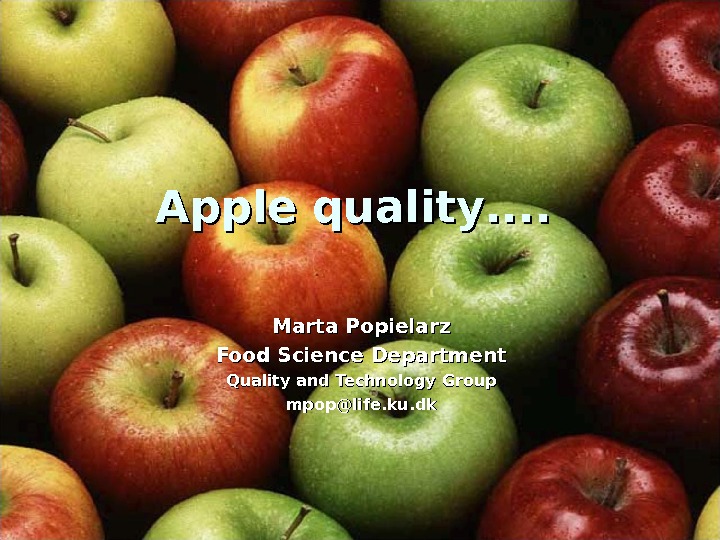
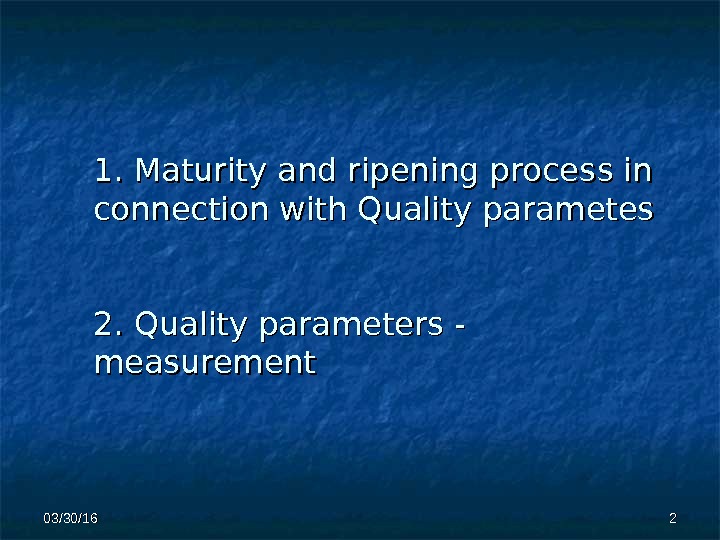
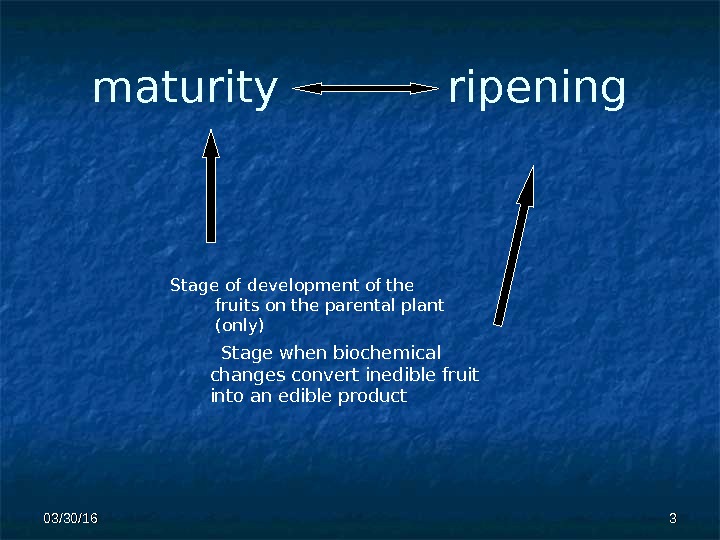
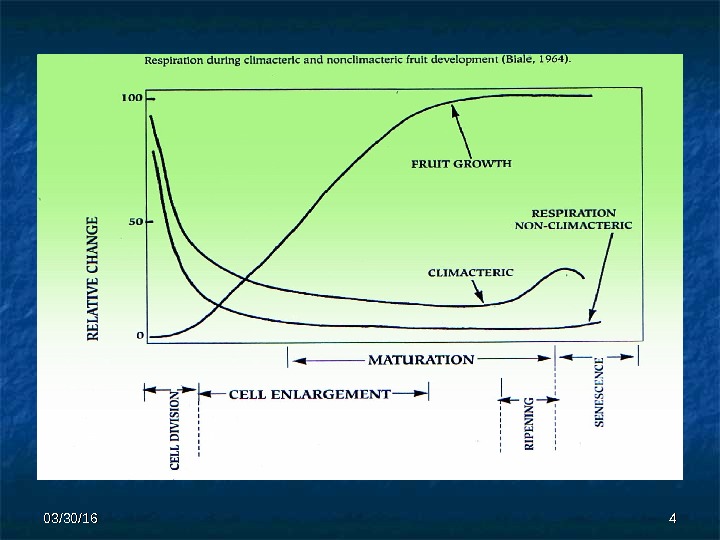
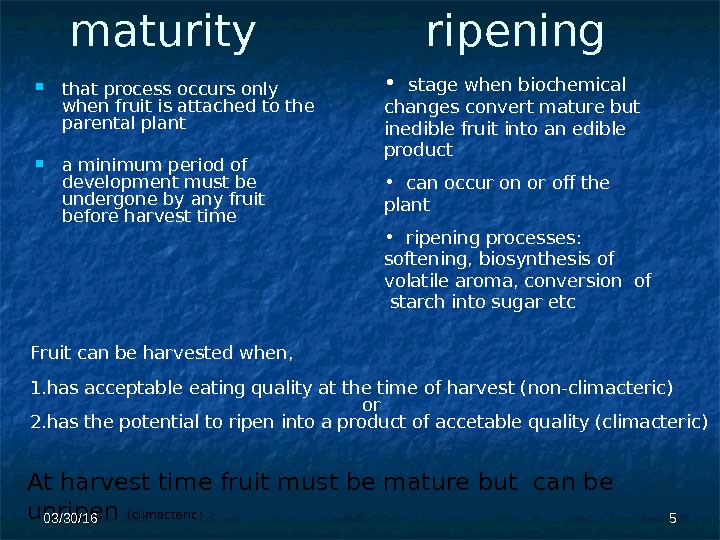
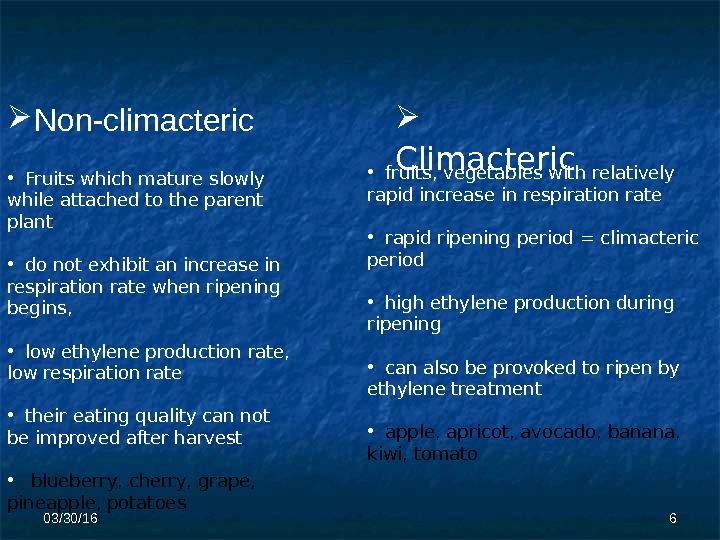
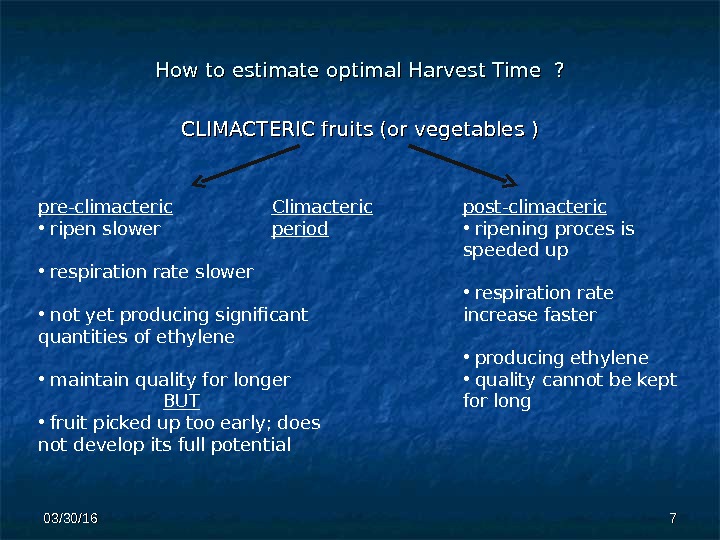
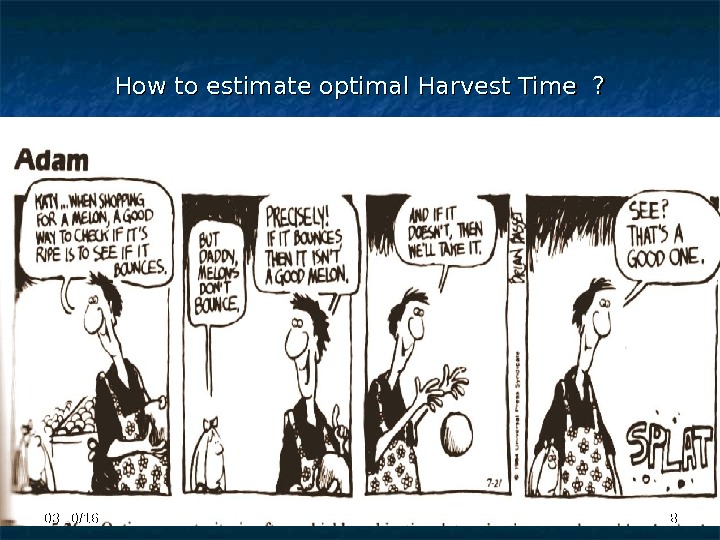

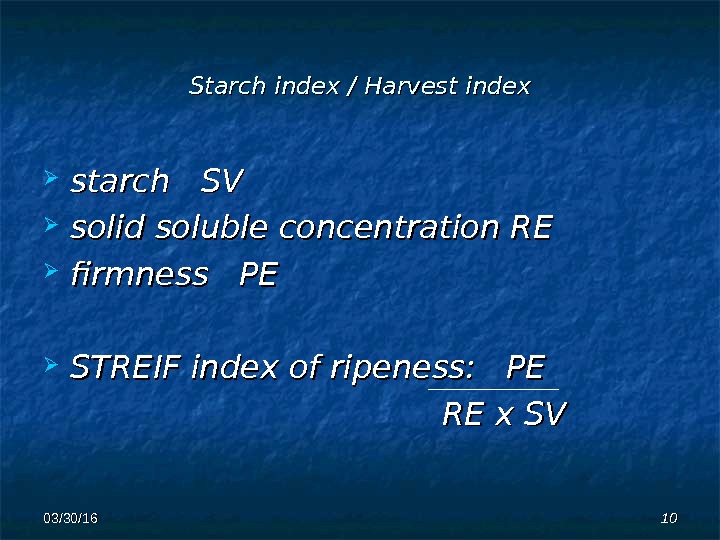
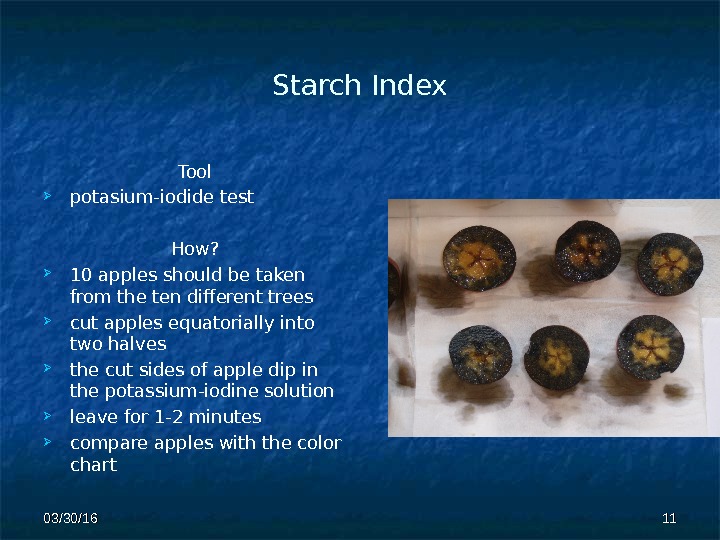


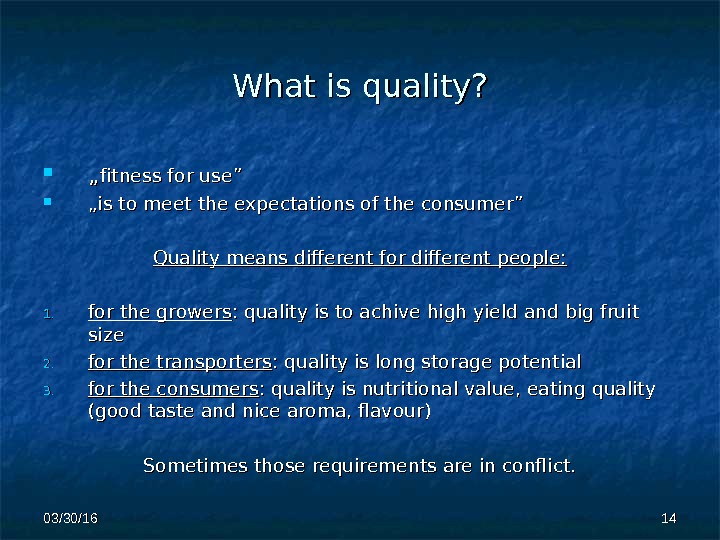
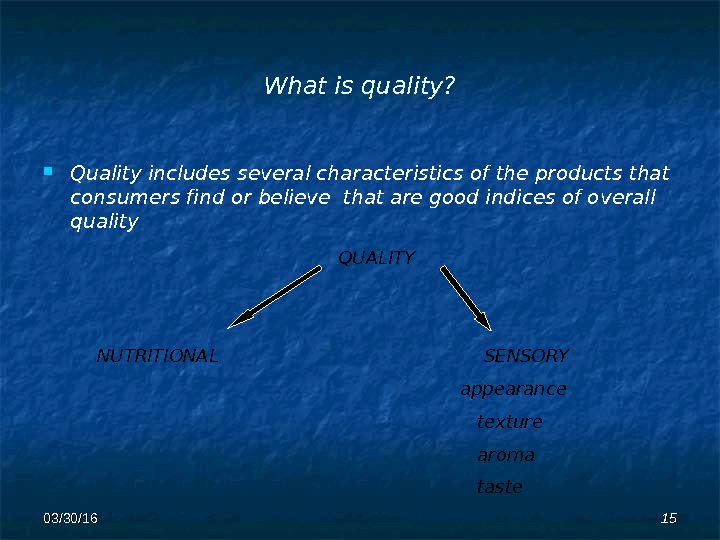
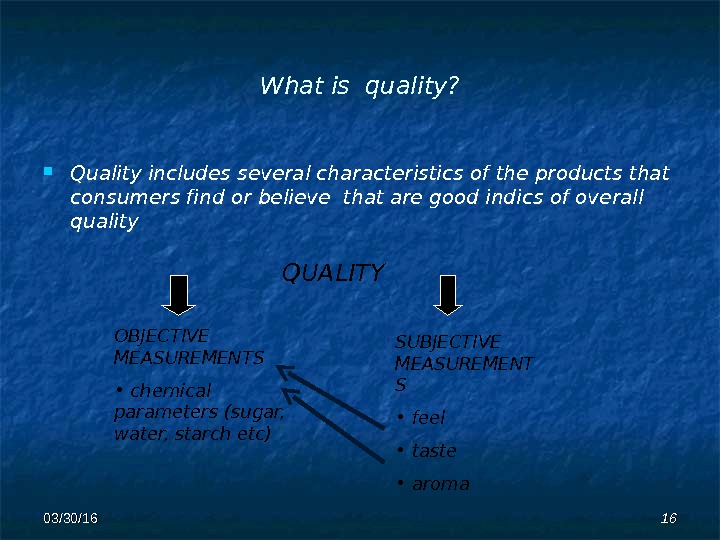


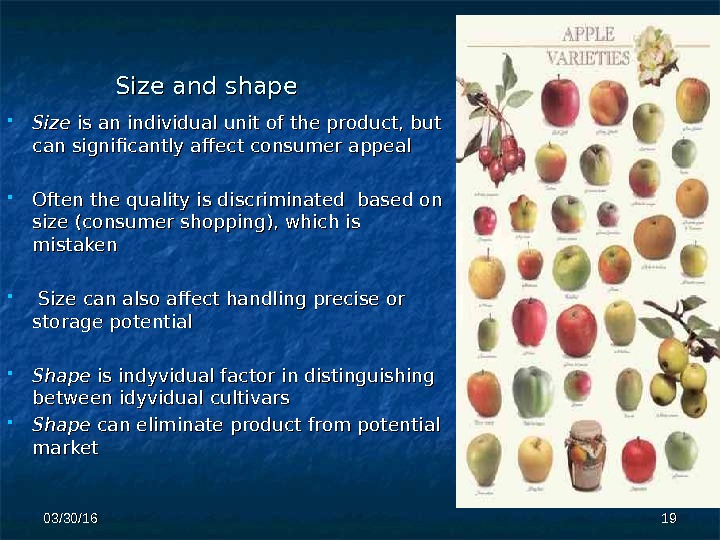
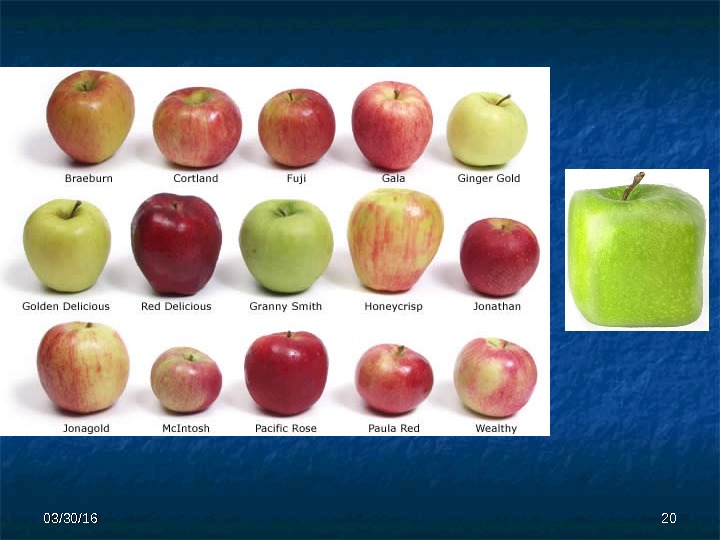
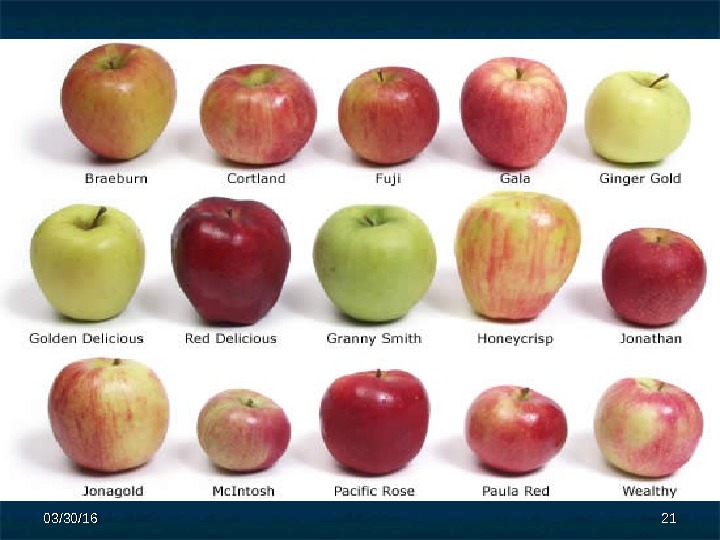
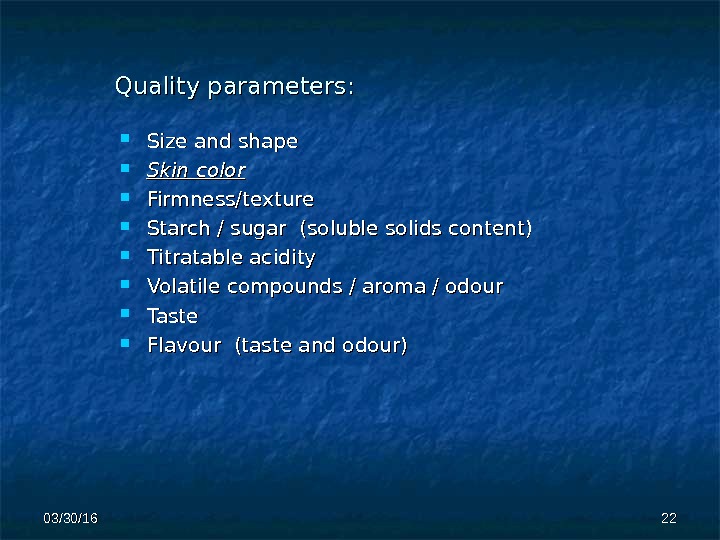
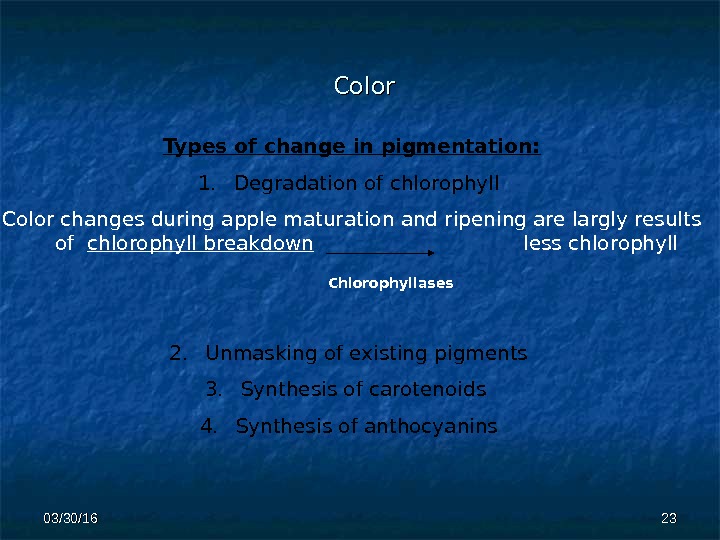
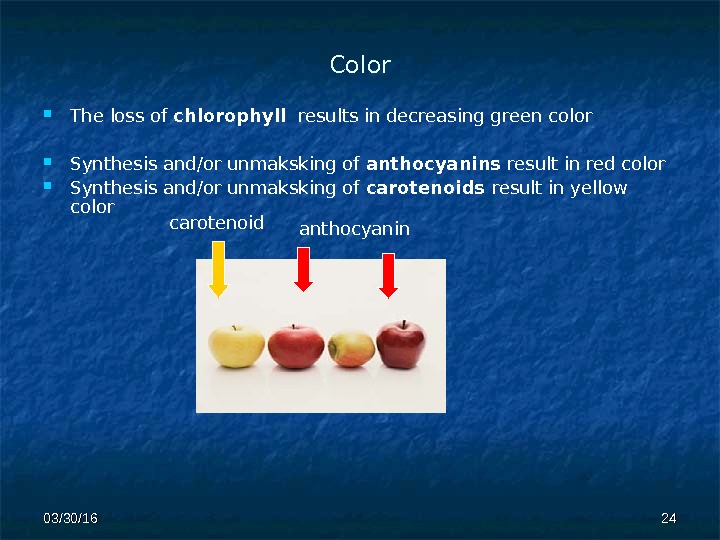
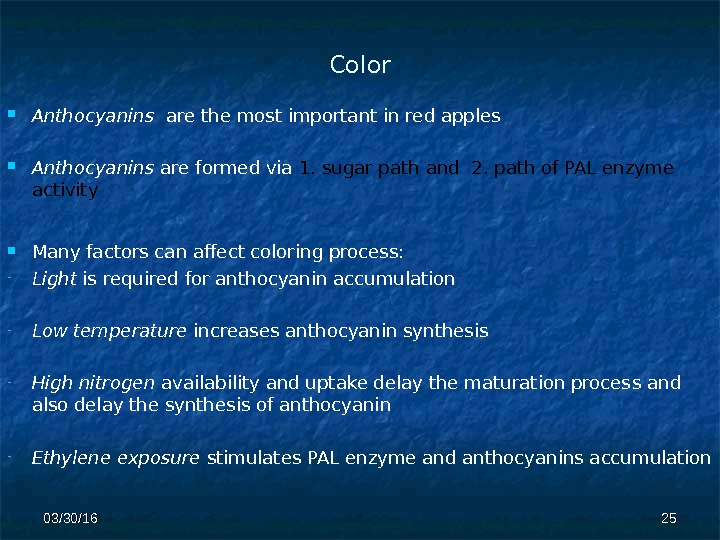
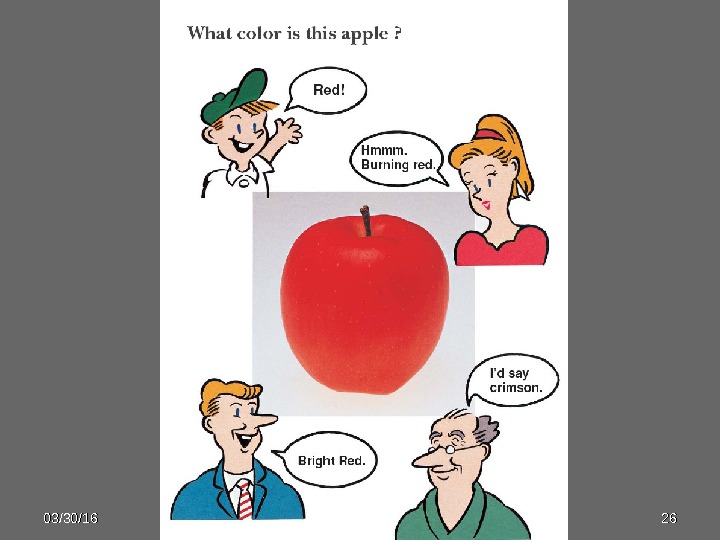
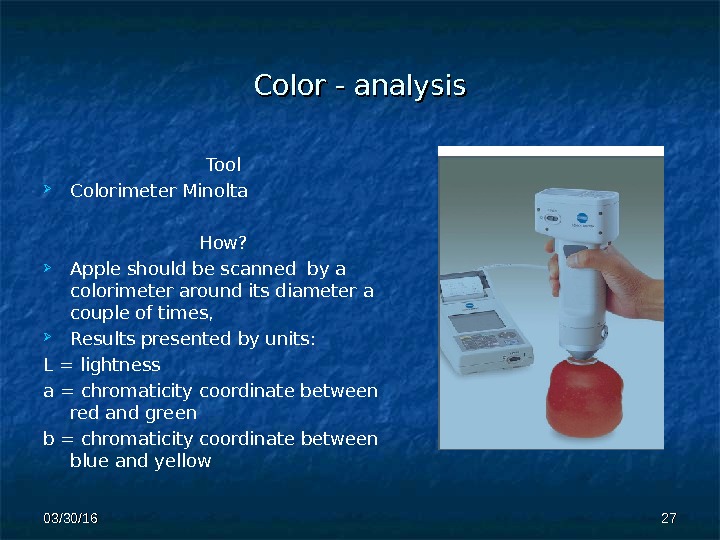
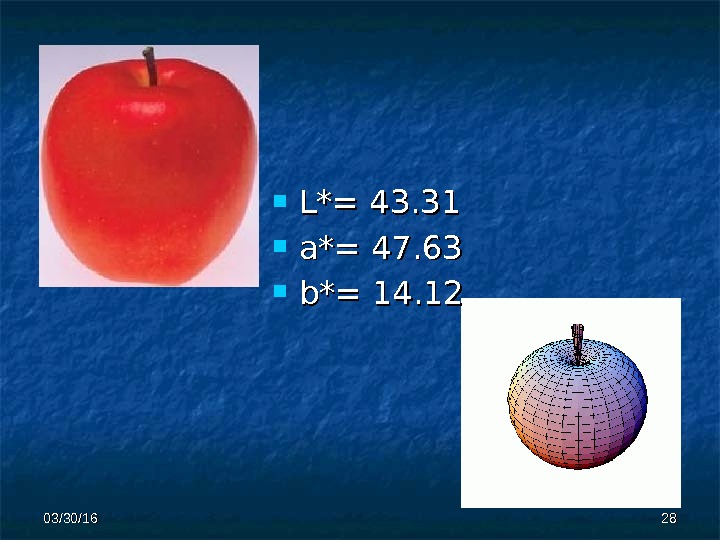
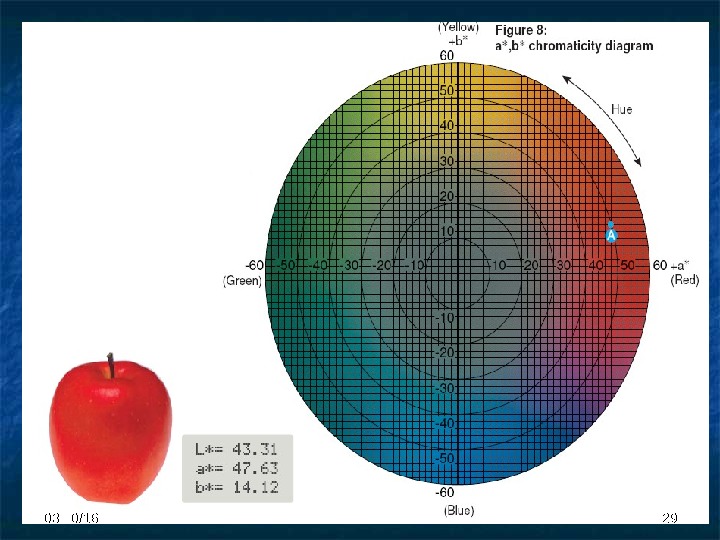
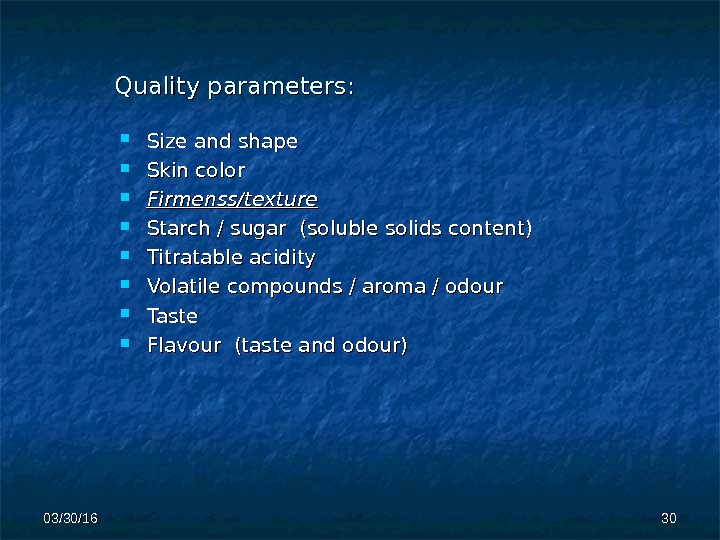
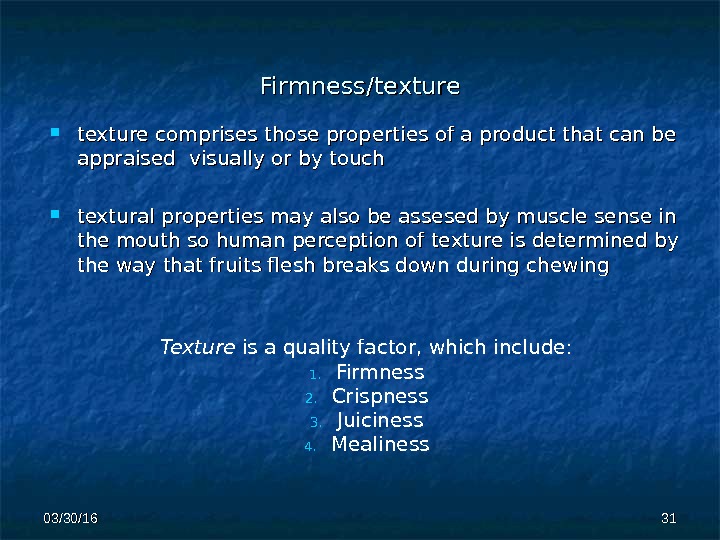
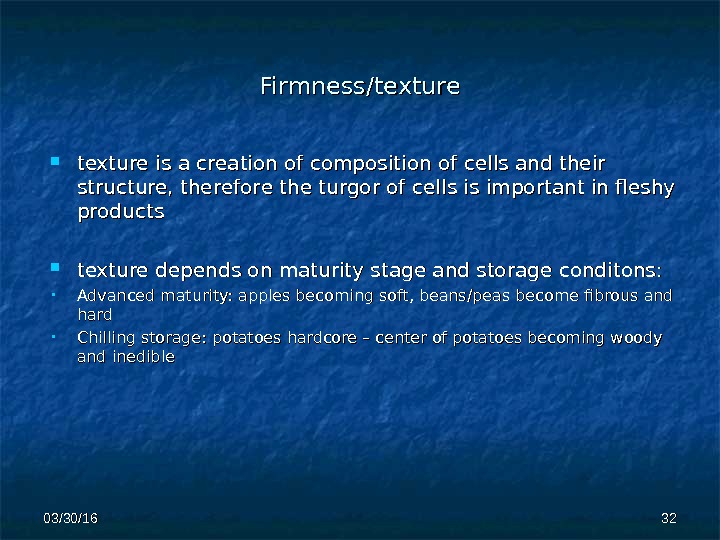
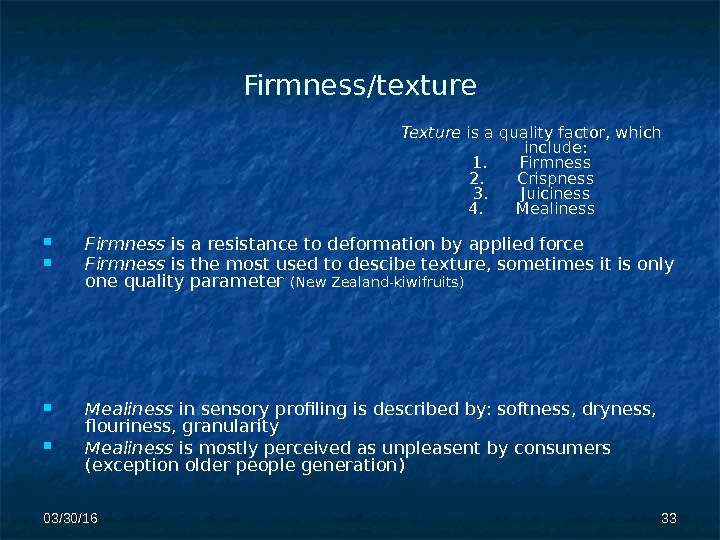
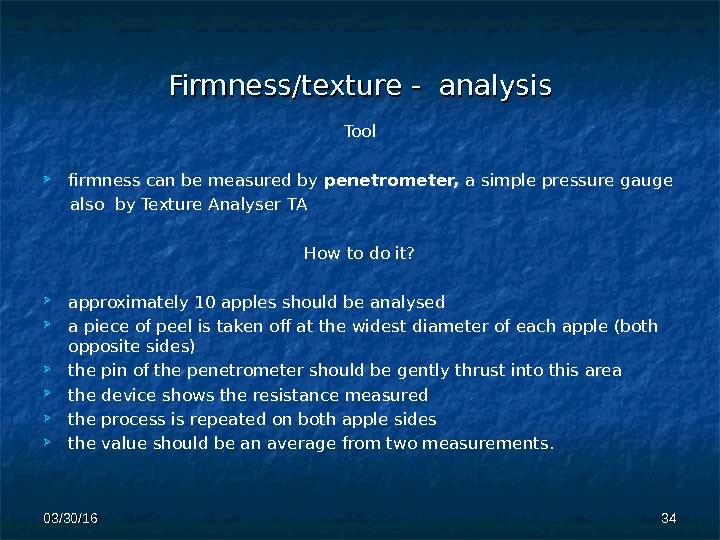

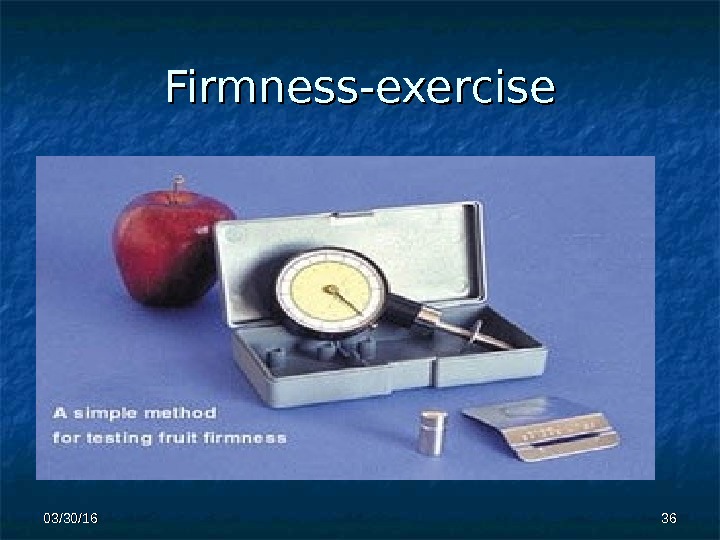
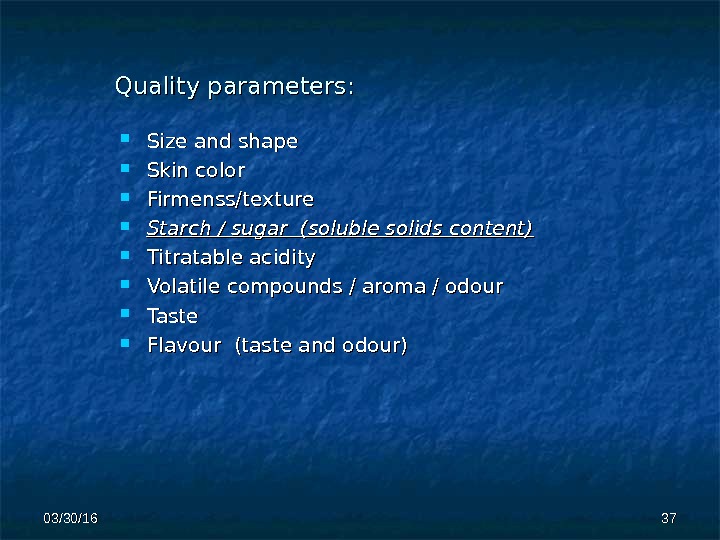
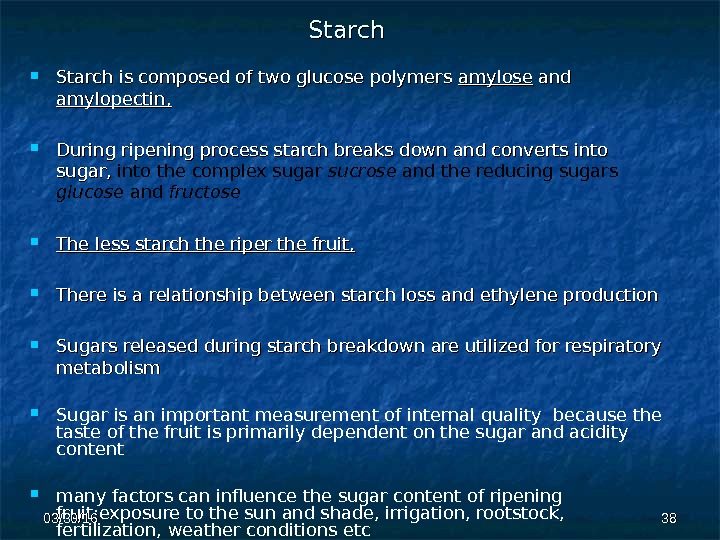

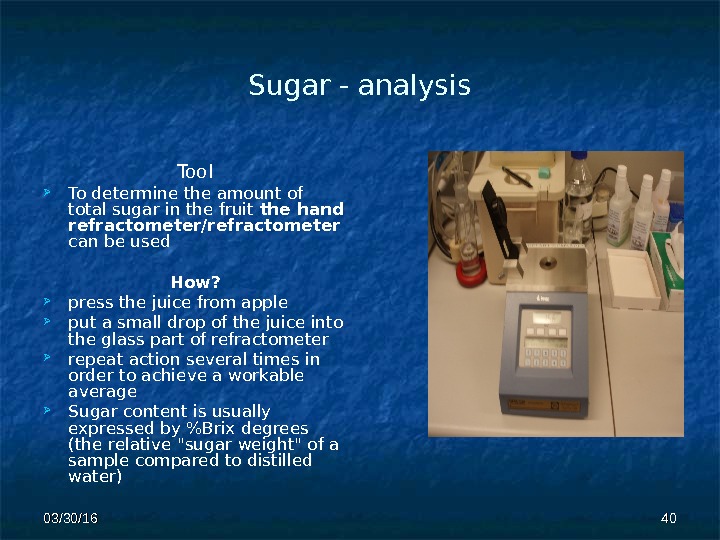
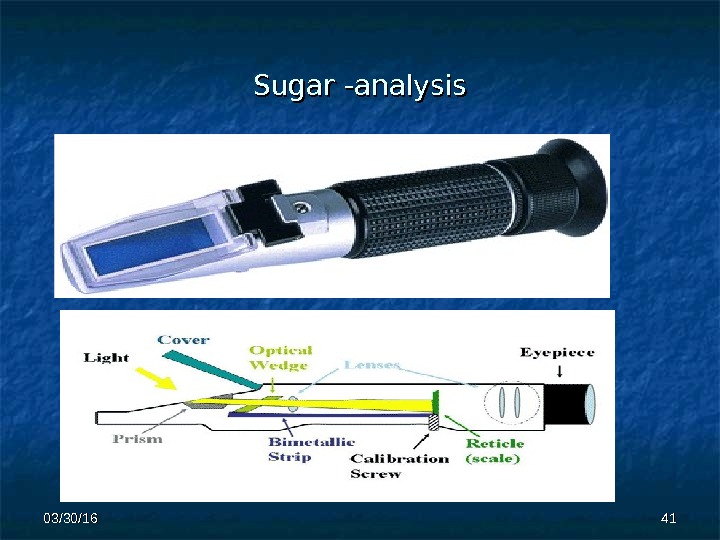
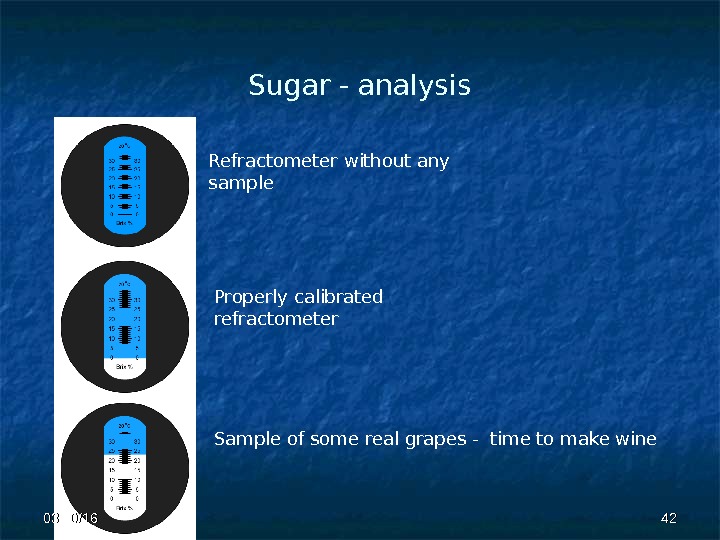
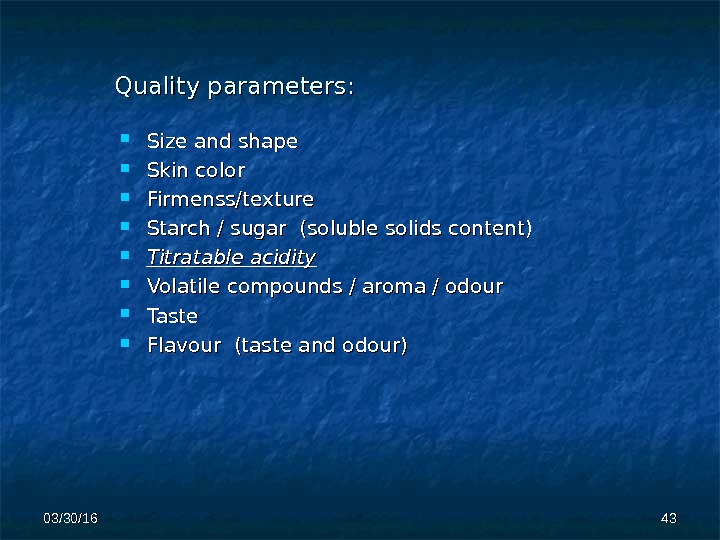
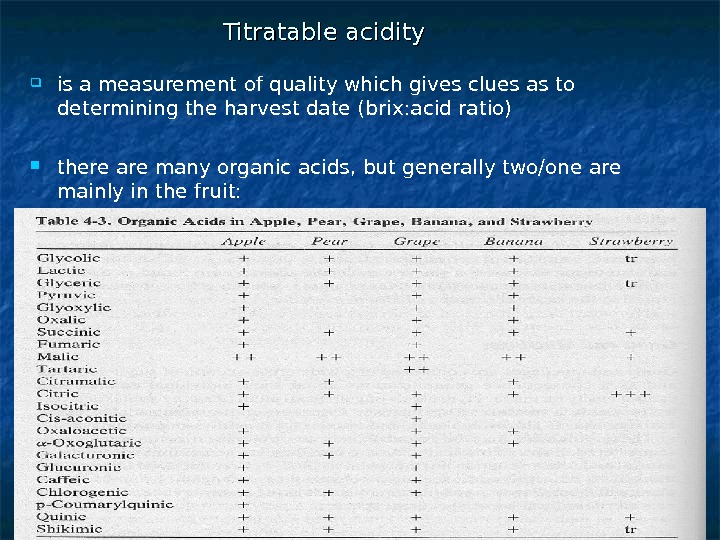
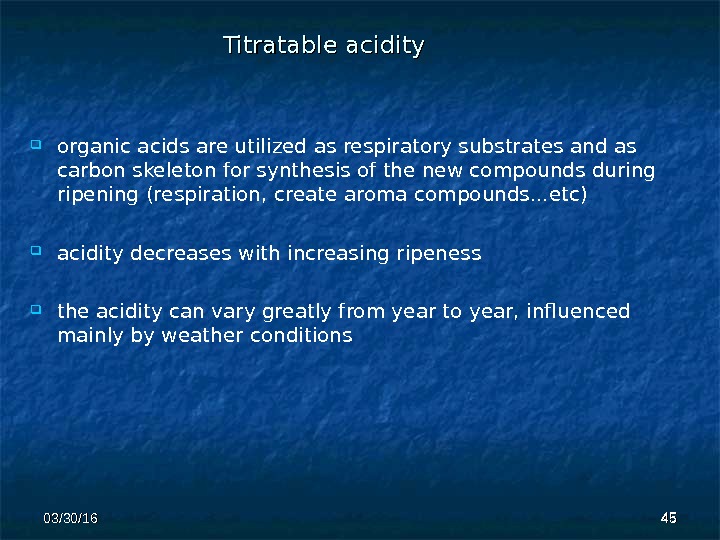
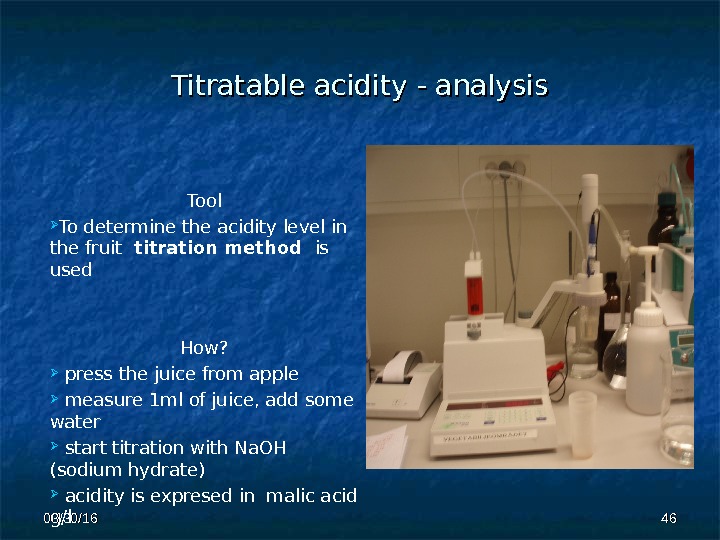

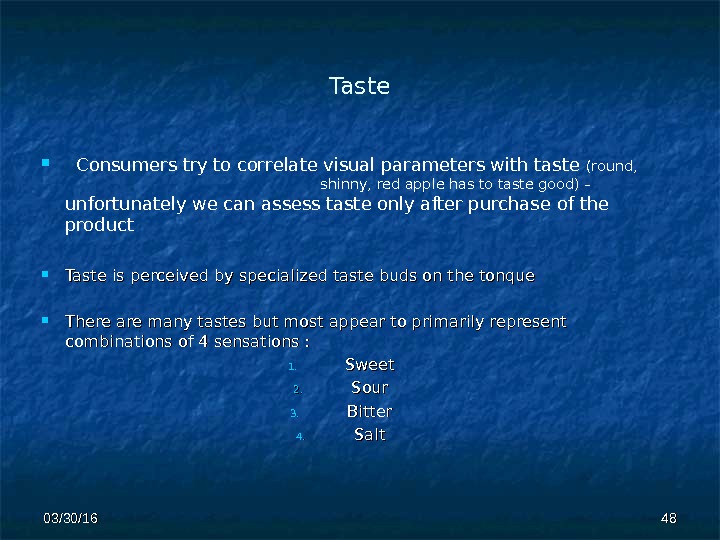
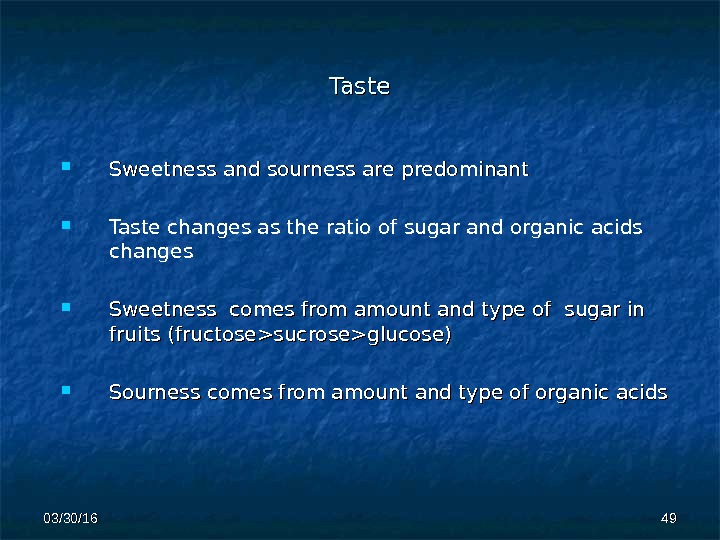

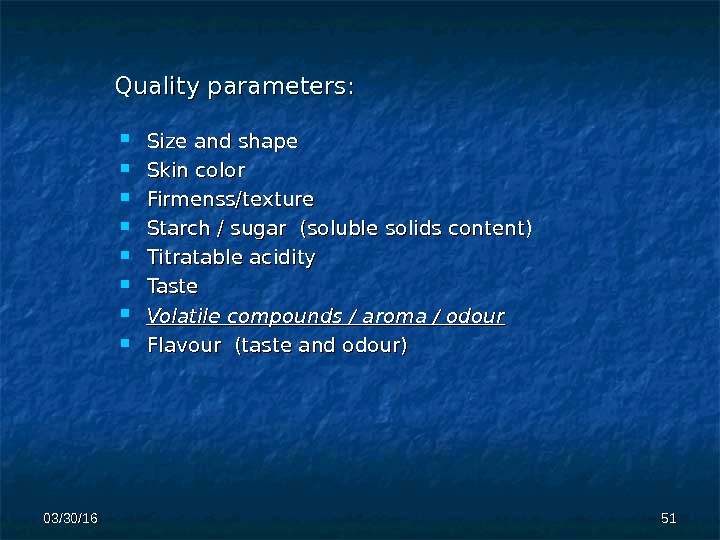

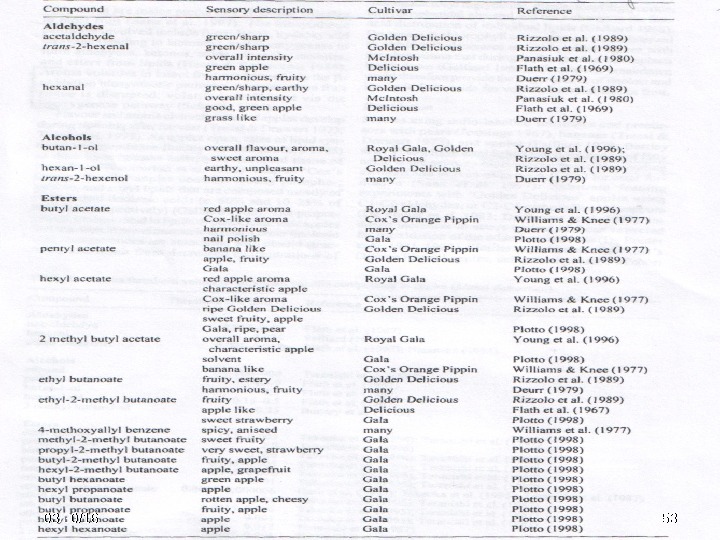
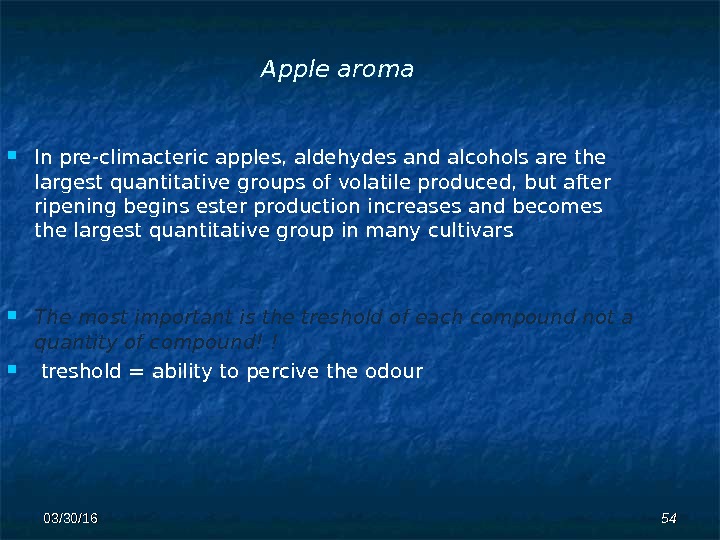
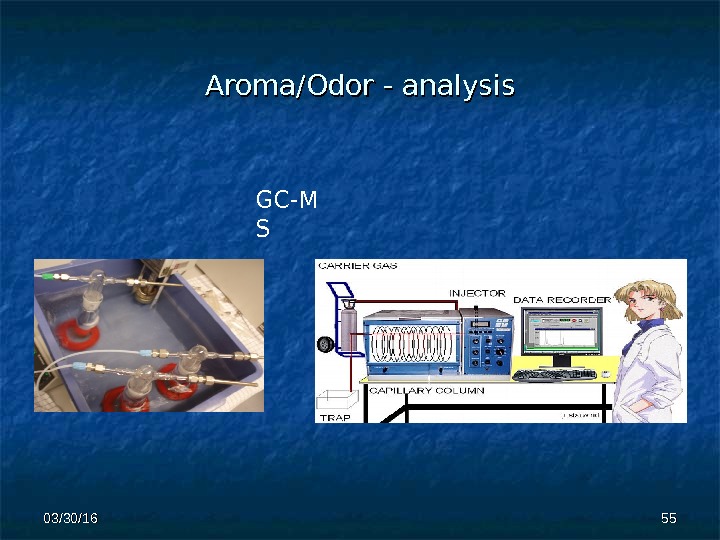
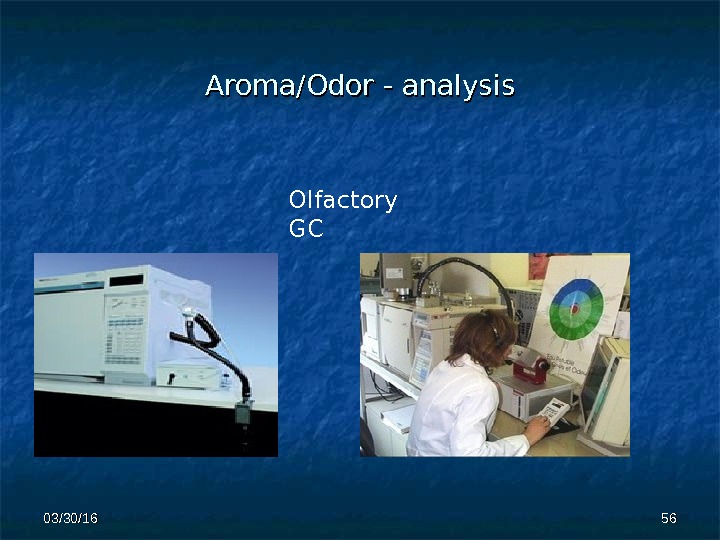
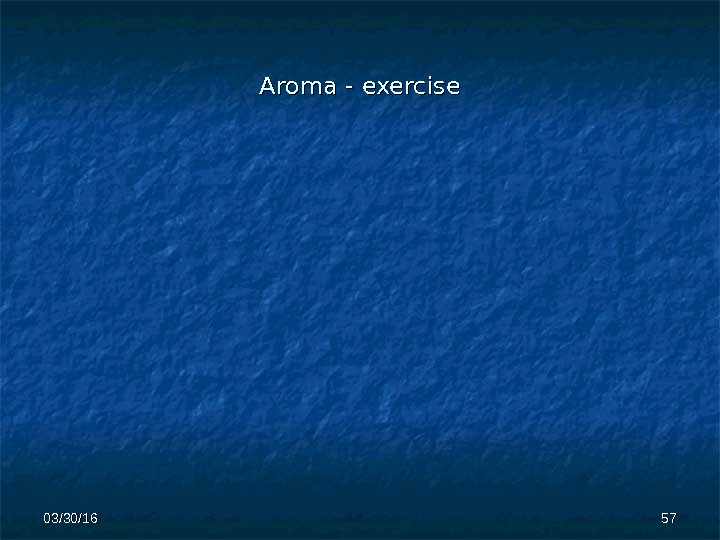
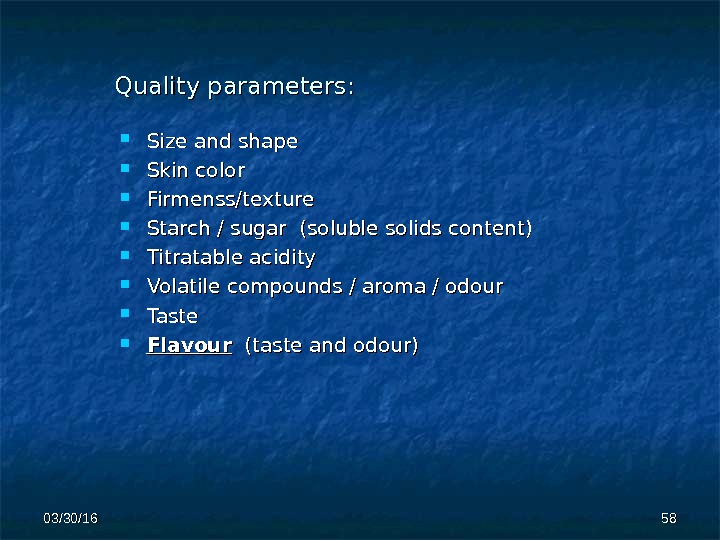
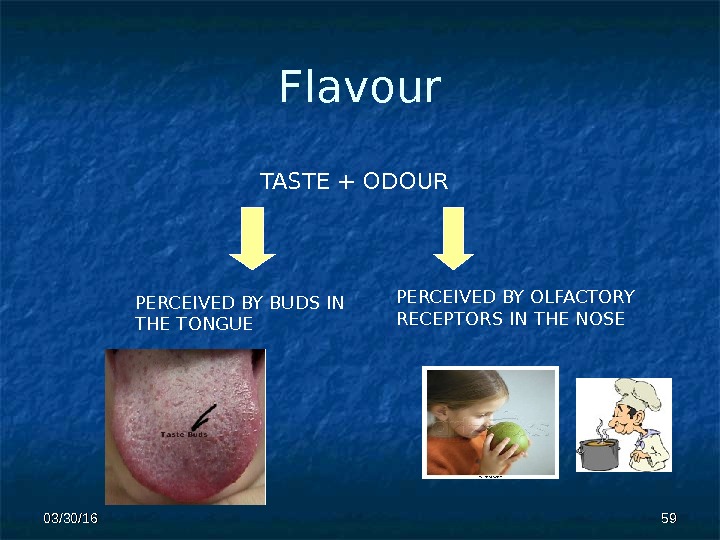
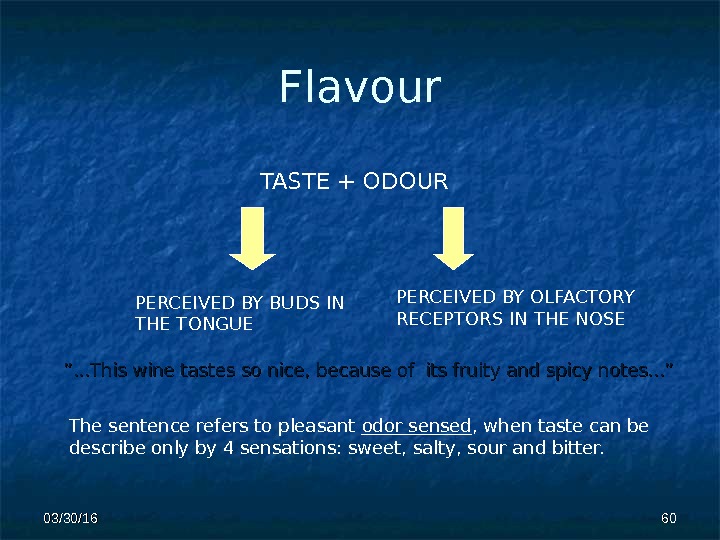
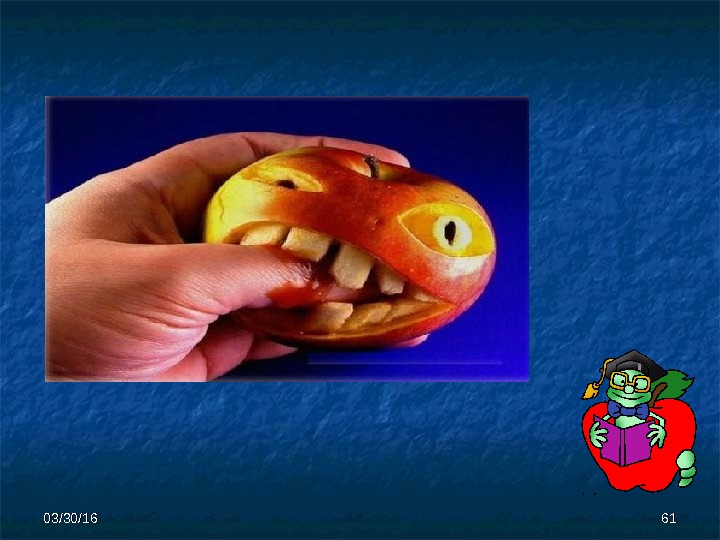
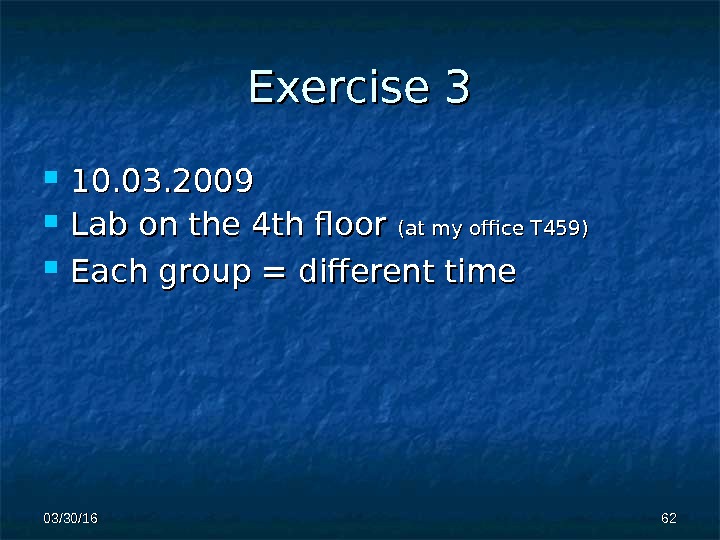

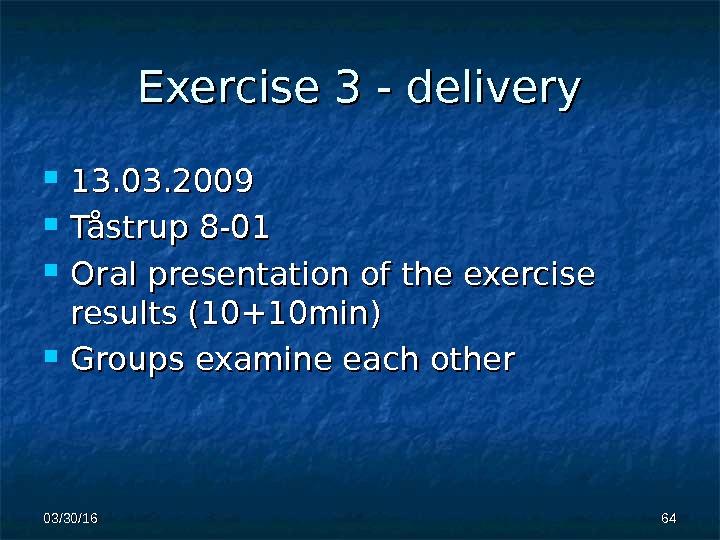
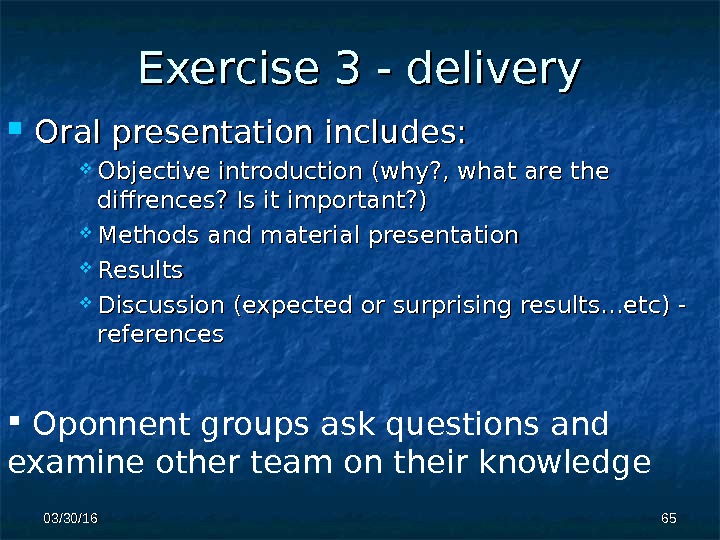
- Размер: 5.7 Mегабайта
- Количество слайдов: 65
Описание презентации Apple quality . . . . по слайдам
 Apple quality. . Marta Popielarz Food Science Department Quality and Technology Group mpop@life. ku. dk
Apple quality. . Marta Popielarz Food Science Department Quality and Technology Group mpop@life. ku. dk
 1. Maturity and ripening proces ss in in concon nn ection with Quality parametes 2. Quality parameters — measurement 22 03/30/
1. Maturity and ripening proces ss in in concon nn ection with Quality parametes 2. Quality parameters — measurement 22 03/30/
 maturity ripening Stage of development of the fruits on the parental plant (only) Stage when biochemical changes convert inedible fruit into an edible product 33 03/30/
maturity ripening Stage of development of the fruits on the parental plant (only) Stage when biochemical changes convert inedible fruit into an edible product 33 03/30/
 44 03/30/
44 03/30/
 that process occurs only when fruit is attached to the parental plant a minimum period of development must be undergo ne by any fruit before harvest time maturity ripening • stage when biochemical changes convert mature but inedible fruit into an edible product • can occur on or off the plant • ripening processes: softening, biosynthesis of volatile aroma, conversion of starch into sugar etc At harvest time fruit must be mature but can be unripen (climacteric)F ruit can be harvested when, 1. has acceptable eating quality at the time of harvest (non-climacteric) or 2. has the potential to ripen into a product of accetable quality (climacteric) 55 03/30/
that process occurs only when fruit is attached to the parental plant a minimum period of development must be undergo ne by any fruit before harvest time maturity ripening • stage when biochemical changes convert mature but inedible fruit into an edible product • can occur on or off the plant • ripening processes: softening, biosynthesis of volatile aroma, conversion of starch into sugar etc At harvest time fruit must be mature but can be unripen (climacteric)F ruit can be harvested when, 1. has acceptable eating quality at the time of harvest (non-climacteric) or 2. has the potential to ripen into a product of accetable quality (climacteric) 55 03/30/
 Non-climacteric Climacteric • fruits, vegetables with relatively rapid increase in respiration rate • r apid ripening period = climacteric period • high ethylene production during ripening • can also be provoked to ripen by ethylene treatment • apple, apricot, avocado, banana, kiwi, tomato • Fruits which mature slowly while attached to the parent plant • do not exhibit an increase in respiration rate when ripening begins, • l ow ethylene production rate, low respiration rate • their eating quality can not be improved after harvest • blueberry, cherry, grape, pineapple, potatoes 66 03/30/
Non-climacteric Climacteric • fruits, vegetables with relatively rapid increase in respiration rate • r apid ripening period = climacteric period • high ethylene production during ripening • can also be provoked to ripen by ethylene treatment • apple, apricot, avocado, banana, kiwi, tomato • Fruits which mature slowly while attached to the parent plant • do not exhibit an increase in respiration rate when ripening begins, • l ow ethylene production rate, low respiration rate • their eating quality can not be improved after harvest • blueberry, cherry, grape, pineapple, potatoes 66 03/30/
 How to estimate optimal Harvest Time ? CLIMACTERIC fruits (or vegetables ) pre-climacteric • ripen slower • respiration rate slower • not yet producing significant quantities of ethylene • maintain quality for longer BUT • fruit picked up too early; does not develop its full potential post-climacteric • ripening proces is speeded up • respiration rate increase faster • producing ethylene • quality cannot be kept for long 77 Climacteric period 03/30/
How to estimate optimal Harvest Time ? CLIMACTERIC fruits (or vegetables ) pre-climacteric • ripen slower • respiration rate slower • not yet producing significant quantities of ethylene • maintain quality for longer BUT • fruit picked up too early; does not develop its full potential post-climacteric • ripening proces is speeded up • respiration rate increase faster • producing ethylene • quality cannot be kept for long 77 Climacteric period 03/30/
 How to estimate optimal Harvest Time ? 88 03/30/
How to estimate optimal Harvest Time ? 88 03/30/
 Determination of harvest date : : There are the principles which decided on which maturity and ripen stage fruit should be picked It It is crucial for storage, marketable life and quality It is important to use objective criteria to decide when crop is ready to pick Several maturity standards has been set for the major crops 99 Maturity standards can be: • starch, • firmness, • titratable acidity, • color changes, • soluble solids content 03/30/
Determination of harvest date : : There are the principles which decided on which maturity and ripen stage fruit should be picked It It is crucial for storage, marketable life and quality It is important to use objective criteria to decide when crop is ready to pick Several maturity standards has been set for the major crops 99 Maturity standards can be: • starch, • firmness, • titratable acidity, • color changes, • soluble solids content 03/30/
 Starch index / HH arvest index starch SV solid soluble concentration RE firmness PE STREIF index of ripeness: PE RE x SV 1010 03/30/
Starch index / HH arvest index starch SV solid soluble concentration RE firmness PE STREIF index of ripeness: PE RE x SV 1010 03/30/
 Starch Index Tool potasium-iodide test How? 10 apples should be taken from the ten different trees cut apples equatorially into two halves the cut sides of apple dip in the potassium-iodine solution leave for 1 -2 minutes compare apples with the color chart 1111 03/30/
Starch Index Tool potasium-iodide test How? 10 apples should be taken from the ten different trees cut apples equatorially into two halves the cut sides of apple dip in the potassium-iodine solution leave for 1 -2 minutes compare apples with the color chart 1111 03/30/
 1212 03/30/
1212 03/30/
 What is quality? 1313 03/30/
What is quality? 1313 03/30/
 What is quality? „„ ff itness for use ”” „„ is to meet the expectations of the consumer” Quality means different for different people: 1. 1. for the growers : quality is to achive high yield and big fruit size 2. 2. for the transporters : quality is long storage potential 3. 3. for the consumers : quality is nutritional value, eating quality (good taste and nice aroma, flavour) Sometimes those requirements are in conflict. 1414 03/30/
What is quality? „„ ff itness for use ”” „„ is to meet the expectations of the consumer” Quality means different for different people: 1. 1. for the growers : quality is to achive high yield and big fruit size 2. 2. for the transporters : quality is long storage potential 3. 3. for the consumers : quality is nutritional value, eating quality (good taste and nice aroma, flavour) Sometimes those requirements are in conflict. 1414 03/30/
 What is quality? Quality includes several chara c teristic s of the products that consumer s f ind or beli e ve that are good indices of overall quality QUALITY NUTRITIONAL SENSORY appearance texture aroma taste 1515 03/30/
What is quality? Quality includes several chara c teristic s of the products that consumer s f ind or beli e ve that are good indices of overall quality QUALITY NUTRITIONAL SENSORY appearance texture aroma taste 1515 03/30/
 What is quality? Quality includes several chara c teristic s of the products that consumer s f ind or beli e ve that are good indics of overall quality QUALITY OBJECTIVE MEASUREMENTS • chemical parameters (sugar, water, starch etc) SUBJECTIVE MEASUREMENT S • feel • taste • aroma 1616 03/30/
What is quality? Quality includes several chara c teristic s of the products that consumer s f ind or beli e ve that are good indics of overall quality QUALITY OBJECTIVE MEASUREMENTS • chemical parameters (sugar, water, starch etc) SUBJECTIVE MEASUREMENT S • feel • taste • aroma 1616 03/30/
 1717 03/30/
1717 03/30/
 Quality parameters : : Size and shape Skin color Firmenss/texture Starch / sugar (soluable solids content) Titratable acidity Volatile compounds / aroma / odour Taste Flavour (taste and odour) 1818 03/30/
Quality parameters : : Size and shape Skin color Firmenss/texture Starch / sugar (soluable solids content) Titratable acidity Volatile compounds / aroma / odour Taste Flavour (taste and odour) 1818 03/30/
 Size and shape Size is an individual unit of the product, but can significantly affect consumer appeal Often the quality is d ii scriminated based on size (consumer shopping), which is mistaken Size can also affect handling precise or storage potential Shape is indyvidual factor in distinguishing between idyvidual cultivars Shape can eliminate product from potential market 1919 03/30/
Size and shape Size is an individual unit of the product, but can significantly affect consumer appeal Often the quality is d ii scriminated based on size (consumer shopping), which is mistaken Size can also affect handling precise or storage potential Shape is indyvidual factor in distinguishing between idyvidual cultivars Shape can eliminate product from potential market 1919 03/30/
 2020 03/30/
2020 03/30/
 2121 03/30/
2121 03/30/
 Quality parameters : : Size and shape Skin color Firmness/texture Starch / sugar (soluble solids content) Titratable acidity Volatile compounds / aroma / odour Taste Flavour (taste and odour) 2222 03/30/
Quality parameters : : Size and shape Skin color Firmness/texture Starch / sugar (soluble solids content) Titratable acidity Volatile compounds / aroma / odour Taste Flavour (taste and odour) 2222 03/30/
 CC olor Chlorophyllases 2323 Types of change in pigmentation: 1. Degradation of chlorophyll Color changes during apple maturation and ripening are largly results of chlorophyll breakdown less chlorophyll 2. Unmasking of existing pigments 3. Synthesis of carotenoids 4. Synthesis of anthocyanins 03/30/
CC olor Chlorophyllases 2323 Types of change in pigmentation: 1. Degradation of chlorophyll Color changes during apple maturation and ripening are largly results of chlorophyll breakdown less chlorophyll 2. Unmasking of existing pigments 3. Synthesis of carotenoids 4. Synthesis of anthocyanins 03/30/
 Color The loss of chlorophyll results in decreasing green color Synthesis and/or unmaksking of anthocyanins result in red color Synthesis and/or unmaksking of carotenoids result in yellow color 2424 carotenoid anthocyanin 03/30/
Color The loss of chlorophyll results in decreasing green color Synthesis and/or unmaksking of anthocyanins result in red color Synthesis and/or unmaksking of carotenoids result in yellow color 2424 carotenoid anthocyanin 03/30/
 Color Anthocyanins are the most important in red apples Anthocyanins are formed via 1. sugar path and 2. path of PAL enzyme activity Many factors can affect coloring process: — Light is require d for anthocyanin accumulation — Low temperature increases anthocyanin synthesis — High nitrogen availabil i ty and uptake delay the maturation proces s and also delay the synthesis of anthocyanin — Ethylene exposure stimulates PAL enzyme and anthocyanins accumulation 03/30/16 2525 03/30/
Color Anthocyanins are the most important in red apples Anthocyanins are formed via 1. sugar path and 2. path of PAL enzyme activity Many factors can affect coloring process: — Light is require d for anthocyanin accumulation — Low temperature increases anthocyanin synthesis — High nitrogen availabil i ty and uptake delay the maturation proces s and also delay the synthesis of anthocyanin — Ethylene exposure stimulates PAL enzyme and anthocyanins accumulation 03/30/16 2525 03/30/
 2626 03/30/
2626 03/30/
 CC olor — analysis Tool Colorimeter Minolta How? Apple should be scanned by a colorimeter around its diameter a couple of times, Results presented by units: L = lightness a = chromaticity coordinate between red and green b = chromaticity coordinate between blue and yellow 2727 03/30/
CC olor — analysis Tool Colorimeter Minolta How? Apple should be scanned by a colorimeter around its diameter a couple of times, Results presented by units: L = lightness a = chromaticity coordinate between red and green b = chromaticity coordinate between blue and yellow 2727 03/30/
 L*= 43. 31 a*= 47. 63 b*= 14. 12 2828 03/30/
L*= 43. 31 a*= 47. 63 b*= 14. 12 2828 03/30/
 2929 03/30/
2929 03/30/
 Quality parameters : : Size and shape Skin color Firmenss/texture Starch / sugar (soluble solids content) Titratable acidity Volatile compounds / aroma / odour Taste Flavour (taste and odour) 3030 03/30/
Quality parameters : : Size and shape Skin color Firmenss/texture Starch / sugar (soluble solids content) Titratable acidity Volatile compounds / aroma / odour Taste Flavour (taste and odour) 3030 03/30/
 Firmness/texture comprises those proptexture comprises those prop ee rties of a product that can be aa pp praised visually or by touch textural prop ee rties may also be assesed by muscle sense in the mouth so human perception of texture is determined by the way that fruits flesh breaks down during chewing Texture is a quality factor, which include: 1. Firmness 2. Crispness 3. Juiciness 4. Mealiness 3131 03/30/
Firmness/texture comprises those proptexture comprises those prop ee rties of a product that can be aa pp praised visually or by touch textural prop ee rties may also be assesed by muscle sense in the mouth so human perception of texture is determined by the way that fruits flesh breaks down during chewing Texture is a quality factor, which include: 1. Firmness 2. Crispness 3. Juiciness 4. Mealiness 3131 03/30/
 Firmness/texture is a creation of composition of cells and their structure, therefor ee the turgor of cells is important in fleshy products texture depends on maturity stage and storage conditons: • Advanced maturity: apples becoming soft, beans/peas become fibrous and hard • Chilling storage: potatoes hardcore – center of potatoes becoming woody and inedible 3232 03/30/
Firmness/texture is a creation of composition of cells and their structure, therefor ee the turgor of cells is important in fleshy products texture depends on maturity stage and storage conditons: • Advanced maturity: apples becoming soft, beans/peas become fibrous and hard • Chilling storage: potatoes hardcore – center of potatoes becoming woody and inedible 3232 03/30/
 Firmness/texture Firmness is a resistance to deformation by applied force Firmness is the most used to descibe texture, sometimes it is only one quality parameter (New Zealand-kiwifruits) Mealiness in sensory profiling is described by: softness, dryness, flouriness, granularity Mealiness is mostly perceived as unpleasent by consumers (exception old e r people generation) 3333 03/30/16 Texture is a quality factor, which include: 1. Firmness 2. Crispness 3. Juiciness 4. Mealiness
Firmness/texture Firmness is a resistance to deformation by applied force Firmness is the most used to descibe texture, sometimes it is only one quality parameter (New Zealand-kiwifruits) Mealiness in sensory profiling is described by: softness, dryness, flouriness, granularity Mealiness is mostly perceived as unpleasent by consumers (exception old e r people generation) 3333 03/30/16 Texture is a quality factor, which include: 1. Firmness 2. Crispness 3. Juiciness 4. Mealiness
 Firmness/texture — analysis Tool firmness can be measured by penetrometer, a simple pressure gauge also by Texture Analyser TA How to do it? approximately 10 apples should be analysed a piece of peel is taken off at the widest diameter of each apple (both opposite sides) the pin of the penetrometer should be gently thrust into this area the device shows the resistance measured the process is repeated on both apple sides the value should be an av e rage fro m two measurements. 3434 03/30/
Firmness/texture — analysis Tool firmness can be measured by penetrometer, a simple pressure gauge also by Texture Analyser TA How to do it? approximately 10 apples should be analysed a piece of peel is taken off at the widest diameter of each apple (both opposite sides) the pin of the penetrometer should be gently thrust into this area the device shows the resistance measured the process is repeated on both apple sides the value should be an av e rage fro m two measurements. 3434 03/30/
 Texture Analyser 3535 03/30/
Texture Analyser 3535 03/30/
 Firmness-exercise 3636 03/30/
Firmness-exercise 3636 03/30/
 Quality parameters : : Size and shape Skin color Firmenss/texture Starch / sugar (soluble solids content) Titratable acidity Volatile compounds / aroma / odour Taste Flavour (taste and odour) 3737 03/30/
Quality parameters : : Size and shape Skin color Firmenss/texture Starch / sugar (soluble solids content) Titratable acidity Volatile compounds / aroma / odour Taste Flavour (taste and odour) 3737 03/30/
 Starch is composed of two glucose polymers amylose and amylopectin, During ripening process starch break s s down and converts into sugar, into the complex sugar sucrose and the reducing sugars glucose and fructose The less starch the riper the fruit, There is a relationship between starch loss and ethylene production Sugars released during starch breakdown are utilized for respiratory metabolism Sugar is an important measurem e nt o f internal quality because the taste of the fruit is primarily dependent on the sugar and acidity content m any factors can influence the sugar content of ripening fruit: expos ure to the sun and shade, irrigation, rootstock, fertilization, weather conditions etc 3838 03/30/
Starch is composed of two glucose polymers amylose and amylopectin, During ripening process starch break s s down and converts into sugar, into the complex sugar sucrose and the reducing sugars glucose and fructose The less starch the riper the fruit, There is a relationship between starch loss and ethylene production Sugars released during starch breakdown are utilized for respiratory metabolism Sugar is an important measurem e nt o f internal quality because the taste of the fruit is primarily dependent on the sugar and acidity content m any factors can influence the sugar content of ripening fruit: expos ure to the sun and shade, irrigation, rootstock, fertilization, weather conditions etc 3838 03/30/
 03/30/
03/30/
 Sugar — analysis Tool To determine the amount of total sugar in the fruit the hand refractometer/refractometer can be used How? press the juice from apple put a small drop of the juice into the glass part of refractometer repeat action several times in order to achi e ve a workable av e rage Sugar content is usually expressed by %Brix degrees (the relative «sugar weight» of a sample compared to distilled water) 4040 03/30/
Sugar — analysis Tool To determine the amount of total sugar in the fruit the hand refractometer/refractometer can be used How? press the juice from apple put a small drop of the juice into the glass part of refractometer repeat action several times in order to achi e ve a workable av e rage Sugar content is usually expressed by %Brix degrees (the relative «sugar weight» of a sample compared to distilled water) 4040 03/30/
 Sugar -analysis 4141 03/30/
Sugar -analysis 4141 03/30/
 Sugar — analysis Refractometer without any sample Properly calibrated refractometer Sample of some real grapes — time to make wine 4242 03/30/
Sugar — analysis Refractometer without any sample Properly calibrated refractometer Sample of some real grapes — time to make wine 4242 03/30/
 Quality parameters : : Size and shape Skin color Firmenss/texture Starch / sugar (soluble solids content) Titratable acidity Volatile compounds / aroma / odour Taste Flavour (taste and odour) 4343 03/30/
Quality parameters : : Size and shape Skin color Firmenss/texture Starch / sugar (soluble solids content) Titratable acidity Volatile compounds / aroma / odour Taste Flavour (taste and odour) 4343 03/30/
 Titratable acidity is a measurem en t of quality which gives clues as to determining the harvest date (brix: acid ratio) there are many organic acids, but generally two/one are mainly in the fruit:
Titratable acidity is a measurem en t of quality which gives clues as to determining the harvest date (brix: acid ratio) there are many organic acids, but generally two/one are mainly in the fruit:
 Titratable acidity organic acids are utilized as respiratory substrates and as carbon skeleton for synthesis of the new compounds during ripening (respiration, create aroma compounds. . . etc) acidity decrease s with increasing r ipeness the acidity can vary greatly from year to year, influenced mainly by weather conditions 03/30/16 4545 03/30/
Titratable acidity organic acids are utilized as respiratory substrates and as carbon skeleton for synthesis of the new compounds during ripening (respiration, create aroma compounds. . . etc) acidity decrease s with increasing r ipeness the acidity can vary greatly from year to year, influenced mainly by weather conditions 03/30/16 4545 03/30/
 Titratable acidity — analysis Tool To determine the acidity level in the fruit titration method is used How? press the juice from apple measure 1 ml of juice, add some water start titration with Na. OH (sodium hydrate) acidity is expresed in malic acid g/l 4646 03/30/
Titratable acidity — analysis Tool To determine the acidity level in the fruit titration method is used How? press the juice from apple measure 1 ml of juice, add some water start titration with Na. OH (sodium hydrate) acidity is expresed in malic acid g/l 4646 03/30/
 Quality parameters : : Size and shape Skin color Firmenss/texture Starch / sugar (soluble solids content) Titratable acidity Taste Volatile compounds / aroma / odour Flavour (taste and odour) 4747 03/30/
Quality parameters : : Size and shape Skin color Firmenss/texture Starch / sugar (soluble solids content) Titratable acidity Taste Volatile compounds / aroma / odour Flavour (taste and odour) 4747 03/30/
 Taste Consumers try to cor r elate visual parameters with taste (round, shinny, red apple has to taste good) – unfortunately we can assess taste only after purchase of the product Taste is perceived by specialized taste buds on the tonque There are many tastes but most appear to prim aa rily represent combinations of 4 sensations : 1. 1. Sweet 2. 2. Sour 3. 3. Bitter 4. 4. Salt 4848 03/30/
Taste Consumers try to cor r elate visual parameters with taste (round, shinny, red apple has to taste good) – unfortunately we can assess taste only after purchase of the product Taste is perceived by specialized taste buds on the tonque There are many tastes but most appear to prim aa rily represent combinations of 4 sensations : 1. 1. Sweet 2. 2. Sour 3. 3. Bitter 4. 4. Salt 4848 03/30/
 Taste Sweetnes ss and sourness are predominant Taste changes as the ratio of sugar and organic acids changes Swe ee tness comes from amount and type of sugar in fruits (fructose>sucrose>glucose) Sourness comes from amount and type of organic acids 4949 03/30/
Taste Sweetnes ss and sourness are predominant Taste changes as the ratio of sugar and organic acids changes Swe ee tness comes from amount and type of sugar in fruits (fructose>sucrose>glucose) Sourness comes from amount and type of organic acids 4949 03/30/
 Taste — exercise 5050 03/30/
Taste — exercise 5050 03/30/
 Quality parameters : : Size and shape Skin color Firmenss/texture Starch / sugar (soluble solids content) Titratable acidity Taste Volatile compounds / aroma / odour Flavour (taste and odour) 5151 03/30/
Quality parameters : : Size and shape Skin color Firmenss/texture Starch / sugar (soluble solids content) Titratable acidity Taste Volatile compounds / aroma / odour Flavour (taste and odour) 5151 03/30/
 Apple Aroma Over 300 volatile compounds have been measured in apples The change in production of volatile compounds by apple fruit is closely linked to ripening process so also to ethylene The types of apple aroma compounds produced typically belong to one of several groups, mostly esters, aldehydes, alcohols, ketons (others in smaller amounts) 5252 03/30/
Apple Aroma Over 300 volatile compounds have been measured in apples The change in production of volatile compounds by apple fruit is closely linked to ripening process so also to ethylene The types of apple aroma compounds produced typically belong to one of several groups, mostly esters, aldehydes, alcohols, ketons (others in smaller amounts) 5252 03/30/
 Apple aroma 5353 03/30/
Apple aroma 5353 03/30/
 Apple aroma In pre-climacteric apples, aldehydes and alcohols are the largest quantitative groups of volatile produced, but after ripening begins ester production increases and becomes the largest quantitative group in many cultivars The most important is the treshold of each compound not a quantity of compound! ! treshold = ability to percive the odour 5454 03/30/
Apple aroma In pre-climacteric apples, aldehydes and alcohols are the largest quantitative groups of volatile produced, but after ripening begins ester production increases and becomes the largest quantitative group in many cultivars The most important is the treshold of each compound not a quantity of compound! ! treshold = ability to percive the odour 5454 03/30/
 Aroma/Odor — analysis 5555 GC-M S 03/30/
Aroma/Odor — analysis 5555 GC-M S 03/30/
 Aroma/Odor — analysis 5656 Olfactory GC 03/30/
Aroma/Odor — analysis 5656 Olfactory GC 03/30/
 Aroma — exercise 5757 03/30/
Aroma — exercise 5757 03/30/
 Quality parameters : : Size and shape Skin color Firmenss/texture Starch / sugar (soluble solids content) Titratable acidity Volatile compounds / aroma / odour Taste Flavour (taste and odour) 5858 03/30/
Quality parameters : : Size and shape Skin color Firmenss/texture Starch / sugar (soluble solids content) Titratable acidity Volatile compounds / aroma / odour Taste Flavour (taste and odour) 5858 03/30/
 Flavour TASTE + ODOUR PERCEIVED BY BUDS IN THE TONGUE PERCEIVED BY OLFACTORY RECEPTORS IN THE NOSE 5959 03/30/
Flavour TASTE + ODOUR PERCEIVED BY BUDS IN THE TONGUE PERCEIVED BY OLFACTORY RECEPTORS IN THE NOSE 5959 03/30/
 Flavour TASTE + ODOUR PERCEIVED BY BUDS IN THE TONGUE PERCEIVED BY OLFACTORY RECEPTORS IN THE NOSE 6060””. . . This wine tastes so nice, because of its fruity and spicy notes. . . ” The sentence refers to pleasant odor sensed , when taste can be describe only by 4 sensations: sweet, salty, sour and bitter. 03/30/
Flavour TASTE + ODOUR PERCEIVED BY BUDS IN THE TONGUE PERCEIVED BY OLFACTORY RECEPTORS IN THE NOSE 6060””. . . This wine tastes so nice, because of its fruity and spicy notes. . . ” The sentence refers to pleasant odor sensed , when taste can be describe only by 4 sensations: sweet, salty, sour and bitter. 03/30/
 03/30/
03/30/
 Exercise 3 10. 03. 2009 Lab on the 4 th floor (at my office T 459) Each group = different time 03/30/
Exercise 3 10. 03. 2009 Lab on the 4 th floor (at my office T 459) Each group = different time 03/30/
 Exercise 3 03/30/16 6363 Group 1 (opponent to group …) at 15. 15 Aslan, Ozlem Ø stergaard, Anne Betzer, Cathrine Group 2 (opponent to group …) at 11. 00 Zidova, Petra Dedenroth, Stine Elise Yilmaz, Tuba Group 3 (opponent to group …) at 15. 00 Demir, Kevser Burcu Weinreich, Christine Frigaard Desta, Zeratsion Abera Group 4 (opponent to group …) at 14. 00 Thach, Tine Dobrynin, Aleksey Stalmach, Joanna Group 5 (opponent to group …) at 14. 30 Gardin, Jeanne Shahid, Aleena Gruca, Marta Helene Group 6 (opponent to group …) at 13. 00 Sarica, G ü lsen Hansen, Majbrit Rodriguez Algaba, Julian Group 7 (opponent to group …) at 13. 30 Jacobsen, Stine Kramer Orhan, Damla Kemezys, Andrius Group 8 (opponent to group …) at 11. 30 Mutlu, Ayse Ceren Kjeldgaard, Karina Juhlert Mlynek, Janus Cronquist Mengistu, Fekadu Gebretensay
Exercise 3 03/30/16 6363 Group 1 (opponent to group …) at 15. 15 Aslan, Ozlem Ø stergaard, Anne Betzer, Cathrine Group 2 (opponent to group …) at 11. 00 Zidova, Petra Dedenroth, Stine Elise Yilmaz, Tuba Group 3 (opponent to group …) at 15. 00 Demir, Kevser Burcu Weinreich, Christine Frigaard Desta, Zeratsion Abera Group 4 (opponent to group …) at 14. 00 Thach, Tine Dobrynin, Aleksey Stalmach, Joanna Group 5 (opponent to group …) at 14. 30 Gardin, Jeanne Shahid, Aleena Gruca, Marta Helene Group 6 (opponent to group …) at 13. 00 Sarica, G ü lsen Hansen, Majbrit Rodriguez Algaba, Julian Group 7 (opponent to group …) at 13. 30 Jacobsen, Stine Kramer Orhan, Damla Kemezys, Andrius Group 8 (opponent to group …) at 11. 30 Mutlu, Ayse Ceren Kjeldgaard, Karina Juhlert Mlynek, Janus Cronquist Mengistu, Fekadu Gebretensay
 Exercise 3 — delivery 13. 03. 2009 Tåstrup 8 -01 Oral presentation of the exercise results (10+10 min) Groups examine each other 03/30/
Exercise 3 — delivery 13. 03. 2009 Tåstrup 8 -01 Oral presentation of the exercise results (10+10 min) Groups examine each other 03/30/
 Exercise 3 — delivery Oral presentation includes: Objective introduction (why? , what are the diffrences? Is it important? ) Methods and material presentation Results Discussion (expected or surprising results. . . etc) — references 03/30/16 6565 Oponnent groups ask questions and examine other team on their knowledge
Exercise 3 — delivery Oral presentation includes: Objective introduction (why? , what are the diffrences? Is it important? ) Methods and material presentation Results Discussion (expected or surprising results. . . etc) — references 03/30/16 6565 Oponnent groups ask questions and examine other team on their knowledge

